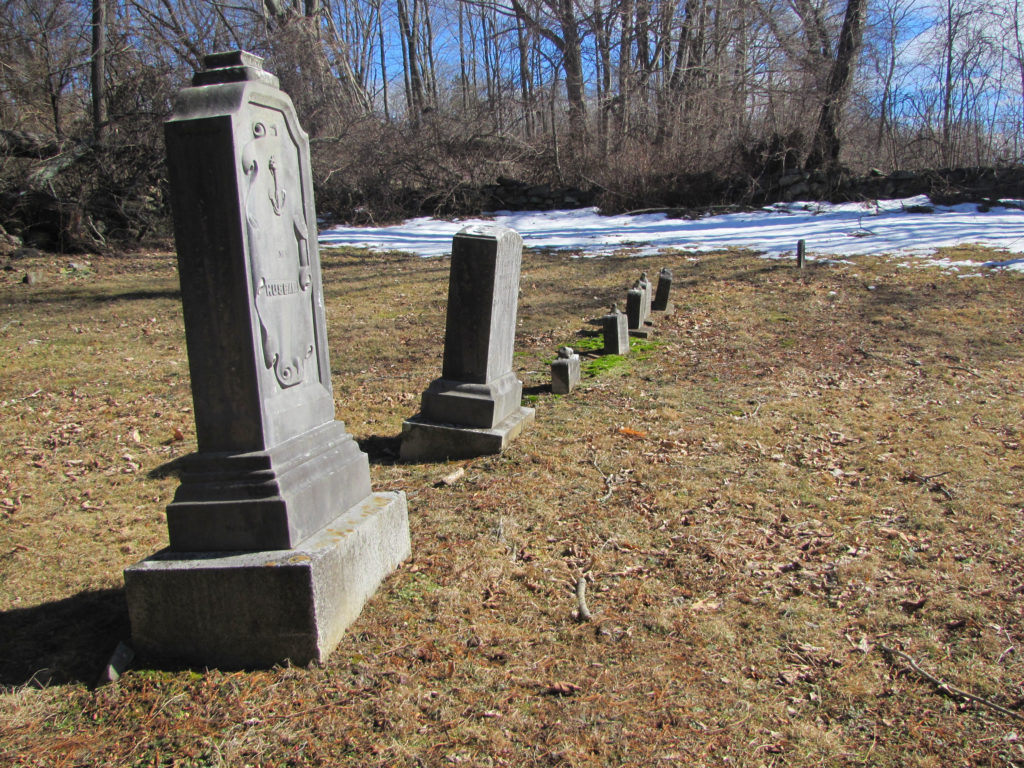
Sarah Gray erected the large headstone in the Liberty Hill Cemetery in Lebanon (far left) over Sluman’s remains—remains that she carted thousands of miles back in a barrel after he died at sea. The epitaph is on the reverse side; the side shown here has an image of an anchor and the words “My Husband.” The next stone is their daughter Kate’s; the five small stones capped with lambs are for their five children who died before the age of 3. Sarah is also interred here. photo: Howard Wayland
By Alicia Wayland
(c) Connecticut Explored Inc. Summer 2013
Subscribe/Buy the Issue!
On March 22, 1865, while 400 miles off the coast of Guam, the first mate of the whaling ship James Maury noted in the log that the captain was taken ill. Two days later he was dead. That untimely death—which left his wife and three children stranded at sea—and the James Maury’s subsequent capture by the Confederate CSS Shenandoah became the stuff of legends—false ones, that is.
The captain was Sluman L. Gray of Lebanon, Connecticut, age 51, whose previous voyages as whaling master included stints on the Mercury (1842-1844), Newburyport (1844-1847), Jefferson (1847-1849), Hannibal (1849-1851), and Montreal (1853-1857). Gray’s career as a whaling master brought him financial success. A captain’s share of the cargo was typically 1/12 of the total value of the cargo, and the returns from his vessels show sizeable quantities of whale oil, sperm oil, and whalebone brought to home ports.
After the voyage of the Hannibal, Gray purchased 10 acres of land in the Liberty Hill section of Lebanon, Connecticut, moving there from New London with his family. He seems to have taken a break from whaling to live the life of a country gentleman after the Montreal returned home in 1857. Gray bought more land and invested in mortgages. He also represented Lebanon in the Connecticut General Assembly in 1863.
Then, in May 1864, seven years after his last voyage, Gray signed on as master of the James Maury out of New Bedford, Massachusetts. Accompanying him was his wife, Sarah Frisbie Gray, and their three children: Kate, 16; Sluman Junior, 10, and Nellie, 2. Only Nellie had never been to sea.
Married in 1838 at age 19, former Pennsylvanian Sarah was a pioneer whaling wife, among the first of an unusual group of women who defied Victorian convention and joined their husbands on long and dangerous voyages to the whaling grounds. Only captains were allowed to bring their wives and families with them. Sarah accompanied her husband on every voyage except for that of the Mercury. She was the mother of eight children, three of whom she gave birth to while aboard whaling ships in foreign waters. Sadly, five of the eight children died of natural causes before age three. The eighth child, born November 5, 1863, died just six months later, in April 1864. Two months later Sarah went to sea for the fifth time. Maritime historian Joan Druett, in “She Was a Sister Sailor”: The Whaling Journals of Mary Brewster 1845-1851 (Mystic Seaport, 1992), describes the typical captain’s living quarters as a stateroom with head (toilet), an after cabin or sitting room, and a forward cabin or dining room that had to be shared with the mates or officers. These three cabins, one of which was shared, were the “extent of the wife’s accommodations on the ship.” How the three Gray children fit in is simply not known.
Druett, in several published books on women at sea, including She Went A-Whaling: The Journal of Martha Smith Brewer Brown from Orient, Long Island, New York, Around the World on the Whaling Ship ‘Lucy Inn’ (Oysterponds Historical Society, 1993), documents Sarah’s voyages through the letters and diaries of other whaling wives who mentioned her, and the diary of a cabin boy aboard the Hannibal. These brief glimpses indicate that Captain Gray provided lavishly for his wife and children but was also a cruel master who flogged his crew for minor mishaps.
On June 1, 1864, the James Maury, with the Gray family on board, left New Bedford, bound for the whaling grounds of the Pacific and Arctic oceans. But this was one whaling voyage that Sluman Gray would not complete. On March 24, 1865, the first mate recorded “Captain Gray expired at 2 p.m. after an illness of 2 days.” The next day he wrote that the ship’s cooper had made a cask and they had put the Captain in it with “spirits.”
While the practice was unusual, there are other instances of bodies of men who died overseas being preserved in barrels of rum or whiskey and shipped home for burial. The most famous to be so treated was Admiral Horatio Nelson, mortally wounded at the Battle at Cape Trafalgar in 1805, whose body was placed in a barrel of “refined spirits” for transport back to England.
The James Maury headed for Guam so Sarah could find a way back home, but there were no ships in port. She decided to remain aboard the James Maury for the summer season. She wrote a letter to a New Bedford whaling newspaper describing what had happened, telling of her husband’s death “from an inflammation of the bowels.” She left the letter on Guam for pick-up by the next vessel headed for New Bedford where it could be delivered. The letter appeared in the Whalemen’s Shipping List and Merchants’ Transcript on August 8, 1865.
The James Maury caught up with the American whaling fleet in the Bering Sea in June. And so, too, did the Confederate raider, the CSS Shenandoah, whose captain was under orders to find and destroy the whaling fleet as a blow to Union commerce. Under the command of James I. Waddell, the Shenandoah had already captured and destroyed nine U.S. merchant vessels on the rebel ship’s way from England, where it had been secretly purchased by the Confederate navy in October 1864, to the Pacific. Waddell had heard rumors that the Civil War had ended (which it had, just weeks before) but chose not to believe this without documented proof. From June 22 to June 28, the Shenandoah captured 24 unarmed whaling vessels and destroyed all but a few. Those few were ransomed and then loaded with the crewmen who had been taken prisoner. Not one seaman was wounded or killed.
In his memoirs, written two decades after the event, Waddell recalled that when they took the James Maury, the ship’s mate reported how upset the widow and her children were and that she had “the remains of her husband on board preserved in whiskey.” Waddell sent a message to Sarah assuring her that she was under the Shenandoah’s protection and that the “men of the South did not make war on women and children.” The James Maury was spared because of the presence of the widow Gray, her three children, and the cask containing her husband’s body.
On June 29, the James Maury was ransomed and ordered to sail for Honolulu with 222 of the prisoners jammed on board; they were to be released when the vessel reached that destination. Sarah and her children did not arrive home in Lebanon until March 1866. Probate records show she paid to cart the cask with her husband’s remains from New Bedford to Lebanon, where he was buried at last in the Liberty Hill Cemetery.

Sluman L. Gray, a whaling captain from New London, Connecticut, in 1851 purchased a 10-acre lot in the Liberty Hill section of Lebanon, Connecticut, where he built this house in the Italianate style fashionable at the time. photo: Howard Wayland
Sarah and her fatherless children moved to Ellenville, New York, where her two married sisters lived. Her daughter Kate attended a private school in neighboring Rosendale, where she died after a long illness at age 20. She was buried in the Liberty Hill Cemetery next to the graves of her father and five younger siblings. Thereafter Sarah lived with another sister and then with her newly married daughter Nellie in Rosendale, New York. Sarah died in 1892 and was buried in the Liberty Hill Cemetery with her husband and six children.
No diaries, letters, or memoirs written by the Grays have been located, and no photographs of any of the family members have been found. Many pieces of this family’s story have been gathered from federal census, land, and probate records, newspapers, and maritime records. The true story of Captain Gray’s death at sea was found in the log book of the James Maury by Civil War buffs William and Sandra Kotrba, former residents of Lebanon, who were attempting to correct erroneous legends about the Grays in the 1970s. Those legends unfortunately were perpetuated as recently as David E. Philips’s Legendary Connecticut (Spoonwood Press, 1984). That book includes charges of infanticide against Sarah, who allegedly poisoned her children while their father was out to sea. (One can imagine this story’s starting as gossip about the high number of deaths among the Gray children, but one possible explanation is supplied by Druett, who discusses the high rate of death in children who lived at sea for long periods once they arrived home—including some of the Grays’—in Hen Frigates: Passion and Peril, Nineteenth Century Women at Sea (Simon & Schuster, 1998.) The other fantastical myth is that Captain Gray died from wounds received from cannonballs fired from the Shenandoah in March 1865 and that Sarah took command of the ship and successfully eluded the marauding Confederate cruiser. The one common element in both legend and historical record is the preservation of the captain’s body in the cask of spirits!
Alicia Wayland is the historian for the Town of Lebanon.
Explore!
“Julia Fish Gates: The Life of a Sea Captain’s Wife,” Spring 2009
Read all of our stories about Connecticut’s Maritime history on our TOPICS page
Read all of our stories about the Civil War on our War Stories TOPICS page
